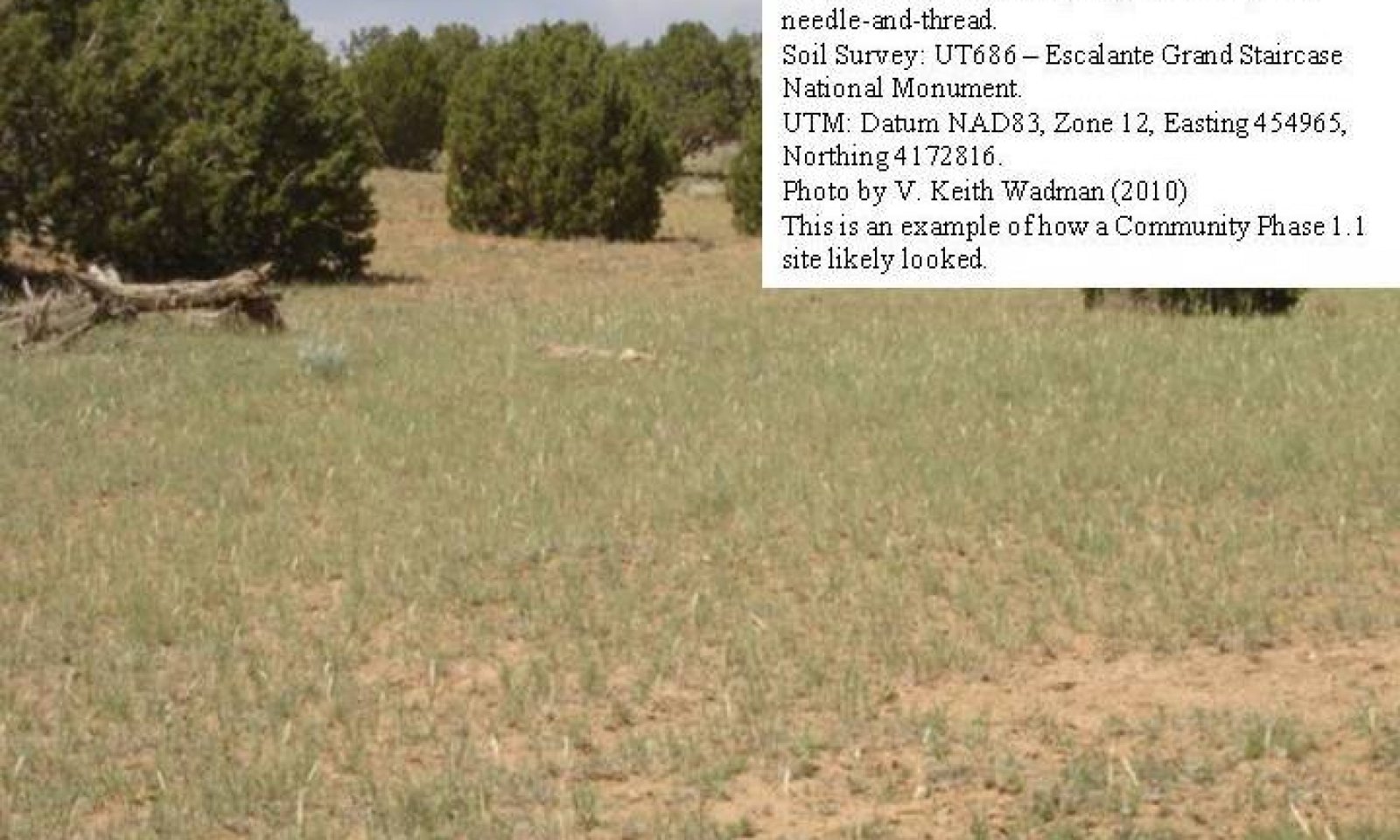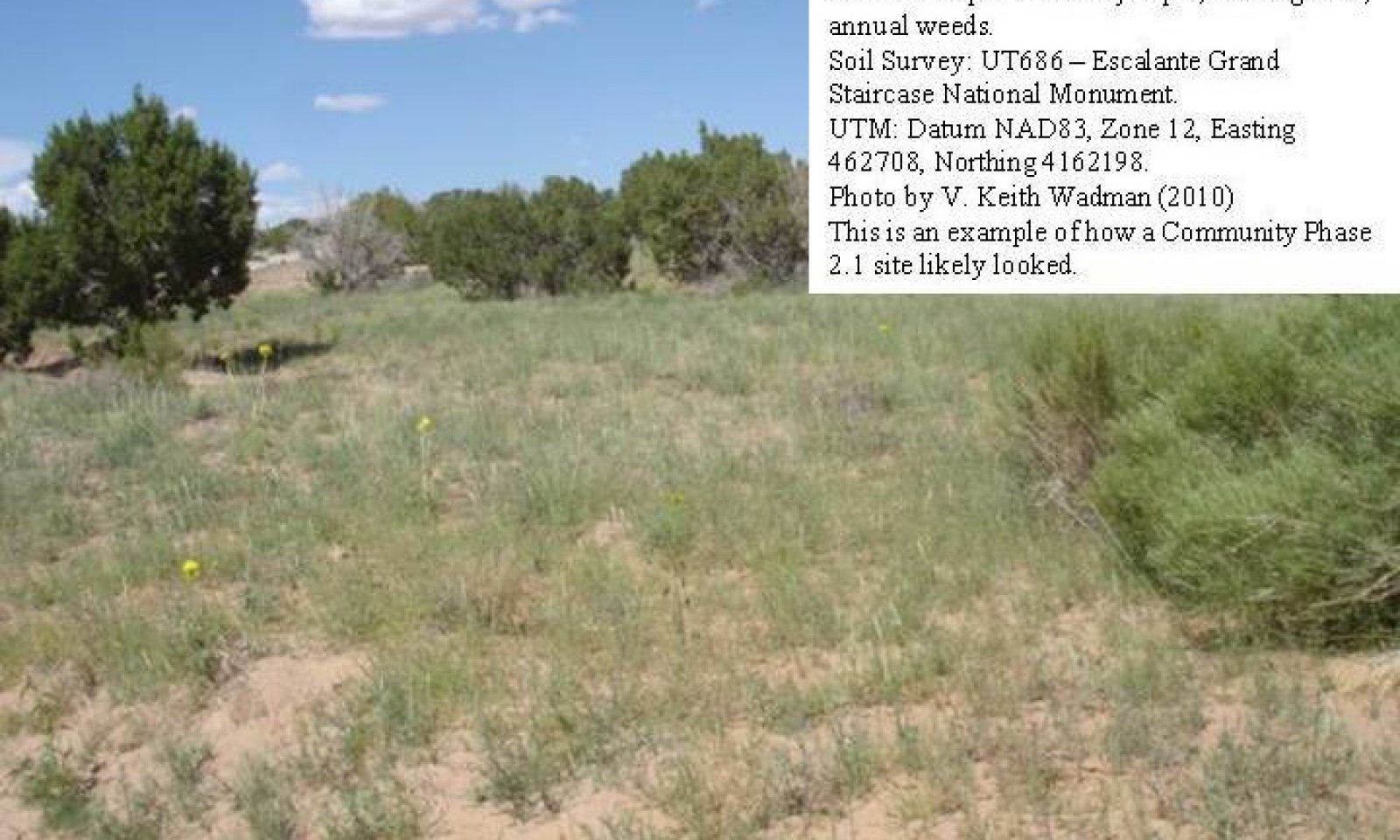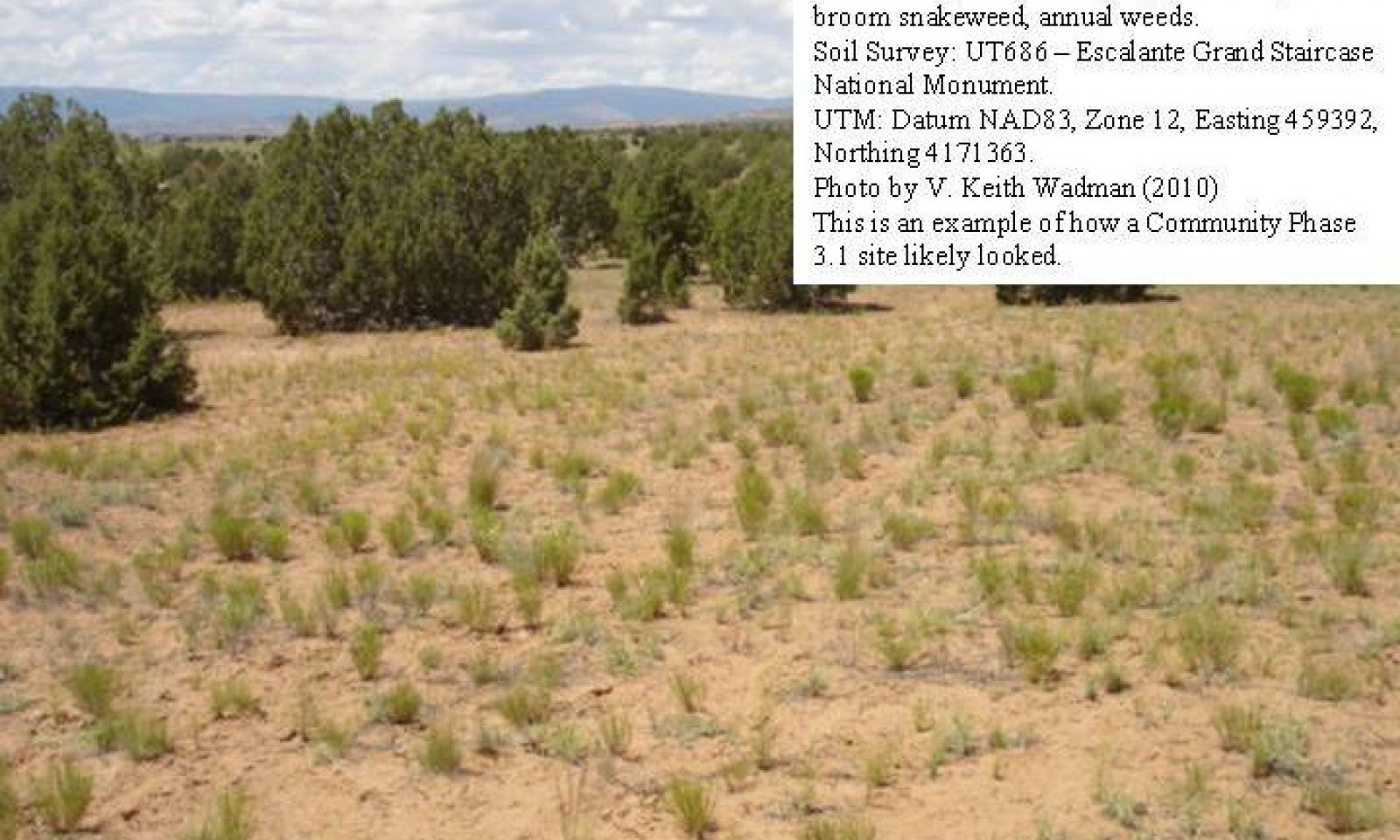
Semidesert Shallow Loam (Utah Juniper- James Galleta)
Scenario model
Current ecosystem state
Select a state
Management practices/drivers
Select a transition or restoration pathway
- Transition T1A More details
- Transition T2A More details
- Transition T2B More details
- Restoration pathway R3A More details
-
No transition or restoration pathway between the selected states has been described
Target ecosystem state
Select a state
State 1
Reference State



Description
This Reference State was determined by the study of rangeland relic areas and areas protected from excessive disturbance and influences such as improper livestock grazing and high impact recreation. Literature reviews, historical accounts and observations of trends in plant community dynamics under a variety of sites has also been considered. Community phases, community pathways, other states, transitions, and thresholds, have been determined through similar studies and experience.
The reference state represents the plant communities and ecological dynamics of the semidesert shallow loam, James galleta, Utah juniper site. This state includes the biotic communities that become established on this ecological site if all successional sequences are completed under the natural disturbance regime. The reference state is generally dominated by James galleta with an overstory canopy of Utah juniper, however depending on disturbance history, other native grasses, forbs, or other shrubs may dominate the site. Utah juniper will naturally increase on this site, in the absence of disturbance, due to its ability to out compete associated understory species. Primary disturbance mechanisms include infrequent fire, climate fluctuations, and native herbivore grazing. The timing of these natural disturbances dictates the ecological dynamics that can occur. The reference state is self sustaining and resistant to change due to high resistance to natural disturbances and high resilience following natural disturbances. When natural disturbances do occur, the rate of recovery is quite variable depending on disturbance intensity. The reference state will naturally fluctuate between community phases 1.1 and 1.2. Once these sites are invaded by non-native species, a return to these community phases may not be possible.
Reference State: Plant communities influenced by infrequent fire, native herbivore grazing, and climate fluctuations.
Indicators: A community dominated by James galleta and Utah juniper where other native perennial grasses and forbs may also be present.
Feedbacks: Natural fluctuations in climate that allow for a self sustaining native grass community. Improper livestock grazing, more frequent fire, or other disturbance that may allow for the establishment of non-native species.
At-risk Community Phase: All communities are at risk when native plants are stressed and nutrients become available for invasive plants to establish.
Trigger: The establishment of non-native invasive plant species.
Submodel
State 2
Current Potential State



Description
The current potential state is similar to the reference state except that non-native, invasive species are now present in all community phases. This state is generally dominated by James galleta with an overystory canopy of Utah juniper, however, depending on disturbance history, other native grasses, forbs, and/or other shrubs may dominate the site. Utah juniper will, in the absence of natural disturbances, increase on this site due to its ability over time to out compete associated understory species. Primary disturbance mechanisms include infrequent fire, weather fluctuations, native herbivore grazing, domestic livestock grazing and surface disturbances such as road and pipeline development and off road vehicle (OHV) use. Timing of these disturbances dictates the ecological dynamics that will occur. The current potential state is still self sustaining; but is losing resistant to change due to a lower resistance to disturbances and a lower resilience following disturbances. When disturbances do occur, the rate of recovery is highly variable depending on severity. The current potential state will naturally fluctuate between community phases 2.1 and 2.2.
Current Potential State: Plant communities influenced by infrequent fire, native herbivore grazing, climate fluctuations, domestic livestock grazing, and other surface disturbances.
Indicators: A community dominated by James galleta and Utah juniper where native other perennial grasses and forbs may also be present. Non-native, invasive grasses and forbs are now present.
Feedbacks: Natural fluctuations in weather that allow for a self sustaining perennial grassland community. Improper livestock grazing which results in a decrease of the perennial grass canopy. Stand replacing fires, or other surface disturbances, which remove Utah juniper. Frequent fire or other disturbance that may allow for the dominance of annual grasses, such as cheatgrass or an increase in broom snakeweed.
At-risk Community Phase: All communities are at risk as increased disturbance frequency allows for the dominance of annual grasses, such a cheatgrass or an incease in broom snakeweed.
Trigger: Reoccurring fire that results in a dominance of cheatgrass or broom snakeweed.
Submodel
State 3
Broom Snakeweed State



Description
This state is characterized by a dominance of broom snakeweed. Native perennial grasses and shrubs may also be present. Native shrubs include Torrey's jointfir, and native grasses include James galleta, blue grama and Indian ricegrass may be present on small amounts. Invasive species such as cheatgrass, tansy mustard, and Russian thistle are typically present in all community phases. Other grasses, forbs, or shrubs may also be present and cover is variable. Utah juniper is often present but it's canopy cover is highly variable.
Broom Snakeweed State: Community phases maintained by improper livestock grazing, time with out disturbances, and fluctuating precipitation trends.
Indicators: A community dominated by broom snakeweed and other invasive species, where native perennial grass and shrubs may also be present.
Feedbacks: A fire or other disturbance that decreases the broom snakeweed cover and allows for the proliferation of cheatgrass. Conditions that allow for continued dominance of broom snakeweed.
At Risk Community Phase: All phases are at risk for the dominance of cheatgrass.
Trigger: A fire or other disturbance that removes the broom snakeweed and allows for the dominance of cheatgrass.
Submodel
Mechanism
This transitional pathway occurs when any combination of extended drought, fire, and improper livestock grazing cause the perennial herbaceous community to become significantly reduced and non-native species such as cheatgrass, russian thistle and ragweed species to become established. Broom snakeween may also increase during this time. Once invasive species occupy the site, a threshold has been crossed.
Mechanism
This transitional pathway occurs when any combination of extended drought, fire, and improper livestock grazing, over long periods of time, cause the perennial herbaceous community to become significantly reduced and non-native species such as cheatgrass, russian thistle and ragweed species to increase. Broom snakeweed also increases during this time and dominates to shrub layer. Once invasive species and broom snakeweed are dominant,a threshold has been crossed.
Mechanism
This transitional pathway occurs when any combination of extended drought, no fire, and improper livestock grazing, over long periods of time, cause the perennial herbaceous community to become significantly reduced and non-native species such as cheatgrass, russian thistle and ragweed species to increase. Broom snakeweed also increases during this time and dominates to shrub layer. Utah juniper dominates the overstory. Once invasive species and broom snakeweed dominate, a threshold has been crossed.
Model keys
Briefcase
Add ecological sites and Major Land Resource Areas to your briefcase by clicking on the briefcase (![]() ) icon wherever it occurs. Drag and drop items to reorder. Cookies are used to store briefcase items between browsing sessions. Because of this, the number of items that can be added to your briefcase is limited, and briefcase items added on one device and browser cannot be accessed from another device or browser. Users who do not wish to place cookies on their devices should not use the briefcase tool. Briefcase cookies serve no other purpose than described here and are deleted whenever browsing history is cleared.
) icon wherever it occurs. Drag and drop items to reorder. Cookies are used to store briefcase items between browsing sessions. Because of this, the number of items that can be added to your briefcase is limited, and briefcase items added on one device and browser cannot be accessed from another device or browser. Users who do not wish to place cookies on their devices should not use the briefcase tool. Briefcase cookies serve no other purpose than described here and are deleted whenever browsing history is cleared.
Ecological sites
Major Land Resource Areas
The Ecosystem Dynamics Interpretive Tool is an information system framework developed by the USDA-ARS Jornada Experimental Range, USDA Natural Resources Conservation Service, and New Mexico State University.


